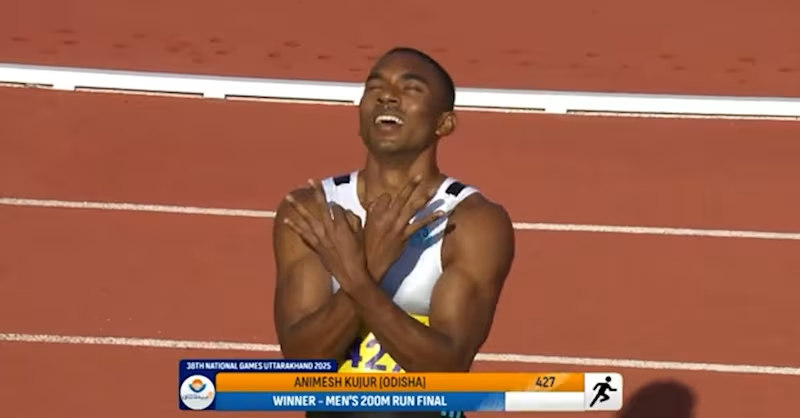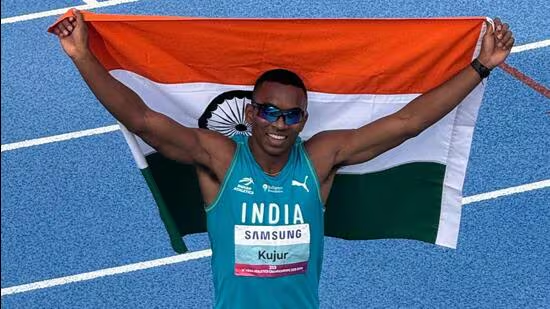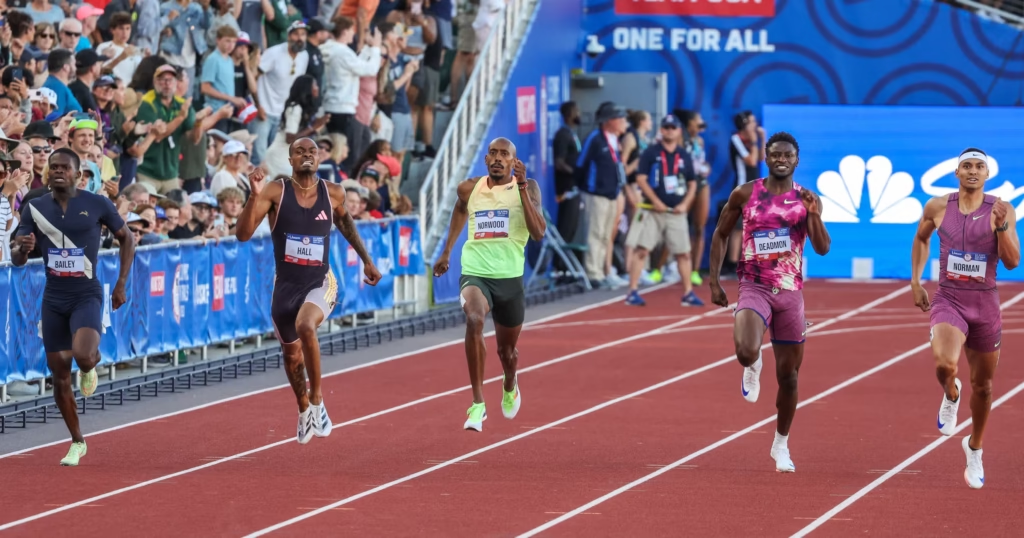In a historic sprint that electrified the track in Vari, Greece, 22-year-old Indian sprinter Animesh Kujur etched his name into the annals of Indian athletics. Competing at the Dromia Sprint and Relay Meet on Saturday, Kujur clocked an astonishing 10.18 seconds in the 100 meters — becoming the first Indian ever to dip below the 10.2-second barrier.
His timing did more than just win him the race; it rewrote the Indian national record, surpassing the previous mark of 10.20 seconds set by Gurindervir Singh earlier this year during the Indian Grand Prix. For Indian athletics, long chasing global standards in sprinting, this moment represents a significant leap forward.

Indian-sprinter-Animesh-Kujur-etched-his-name-into-the-annals-of-Indian-athletics.
The Race That Made History
Lined up in Lane 4, Kujur didn’t have the smoothest of starts. Greek sprinters Theodoros Vrontinos and Sotirios Garagganis got off the blocks faster, pushing ahead in the initial 30 meters. But as the race unfolded, Kujur’s tactical prowess came into play. Maintaining composure, he accelerated with remarkable power in the final 40 meters.
While Vrontinos faded, Kujur surged past Garagganis right at the finish line, clinching both the race win and the record. The clock stopped at 10.18 seconds — a moment that not only cemented his place as India’s fastest man but also signaled a new era for Indian sprinting.

Kujur’s-tactical-prowess-came-into-play-Maintaining-composure-he-accelerated-with-remarkable-power-in-the-final-40-meters.
A Meteoric Rise
Kujur’s achievement in Greece is the latest in a string of milestones in what has been a breakout year for the young sprinter from Chhattisgarh. Known for his prowess in the 200m as well, Kujur rewrote the national record twice in that category earlier this year.
In April 2025, he clocked 20.40 seconds in the 200m, breaking the long-standing national record. Just a month later, he improved on his own mark by clocking 20.32 seconds, a performance that earned him a medal at the Asian Athletics Championships — making him only the second Indian in nearly 50 years to do so.
In June, Kujur posted an even faster time of 20.27 seconds at the AthleticGeneve tournament. Though the wind reading of +2.3 m/s meant it wasn’t eligible for official record status, the performance underscored his growing stature on the international stage.

In-April-2025-he-clocked-20.40-seconds-in-the-200m-breaking-the-long-standing-national-record
European Circuit: The Crucible of Excellence
Kujur’s performance in Greece is no fluke — it’s the culmination of rigorous training and international exposure. His coach and support team had long emphasized the need to compete abroad to bridge the gap between Indian and global standards in sprinting.
It was during a European tour in 2024 that Kujur began to experience a shift in his mindset and performance. Recalling a pivotal 100m race in Finland, Kujur described how racing alongside elite sprinters forced him to elevate his game. Competing against Jamaican sprinter Oshane Bailey (PB: 10.05 seconds), he improved his own timing from 10.50 to 10.39 seconds.
“That’s the difference,” Kujur had explained. “Being around faster athletes compels you to push harder. You learn not just how to run, but how to think like a champion.”
A New Benchmark in Indian Sprinting
Kujur’s 10.18-second run is more than a personal triumph; it’s a symbolic victory for Indian athletics. For decades, Indian sprinters have trailed behind the international elite in the short sprints, with only occasional breakthroughs. Breaking the 10.2-second mark sets a new benchmark, proving that Indian athletes can not only qualify for global finals but also compete as contenders.
In recent years, the athletics ecosystem in India has seen a steady improvement in infrastructure, coaching, and support systems. But it is athletes like Animesh Kujur — those who go beyond national boundaries in their pursuit of excellence — who truly inspire the next generation.

Kujur’s-10.18-second-run-is-more-than-a-personal-triumph-it’s-a-symbolic-victory-for-Indian-athletics
Kujur’s Unique Strengths
What sets Kujur apart isn’t just his speed, but his ability to consistently improve. Unlike many sprinters who plateau early, Kujur’s graph has continued to rise. Analysts point to his exceptional closing speed, mental resilience, and a strong work ethic as key ingredients in his success.
His race in Greece was a textbook example of strategic running. Despite a slower reaction at the blocks, Kujur didn’t panic — a common pitfall for sprinters. Instead, he stayed relaxed and trusted his acceleration phase, unleashing a powerful second half that won him the race.
“He’s learned how to manage the race,” said one of his coaches. “It’s not just about brute speed anymore. It’s about how and when you use it.”
What This Means Going Forward
With the Paris 2025 World Athletics Championships on the horizon and the 2026 Asian Games not far behind, expectations around Kujur will only grow. Indian athletics officials are now eyeing the elusive sub-10-second barrier — a mark no Indian has ever achieved.
While 10.18 seconds still leaves a sizable gap to the world’s top sprinters (with the elite running sub-10s regularly), it places Kujur in striking distance of qualification for global semi-finals and potentially even finals — an almost unthinkable feat for Indian sprinting just a few years ago.
“There’s still room to grow,” Kujur himself admitted in a recent interview. “But this isn’t the end goal. It’s just a step. I want to be among the best, not just in India, but in the world.”

With the Paris 2025 World-Athletics-Championships-on-the-horizon-and-the-2026-Asian-Games-not-far-behind-expectations-around-Kujur
The Road Ahead
Kujur’s training plan is now being fine-tuned for precision. Experts are working on his reaction times, transition mechanics, and speed endurance, all of which will be key to breaking the next barrier. The focus, for now, will be on injury prevention and tapering before bigger meets later this year.
If his upward trajectory holds, Animesh Kujur could become the first Indian sprinter to run a sub-10.10 — or even a sub-10 — in the 100m. That, once a dream, is now a legitimate possibility.
A Moment to Celebrate — and Build Upon
In a sport often dominated by a few nations, Animesh Kujur’s latest performance is a clarion call to dream bigger. His 10.18-second sprint isn’t just a new national record — it’s a symbol of how far Indian athletics has come, and how much further it can go.
For now, though, India can bask in the joy of watching one of its own make history on the international stage. And for young athletes across the country, there’s a new name to look up to — Animesh Kujur, the fastest man in India.
Click here to watch more!



















Comments